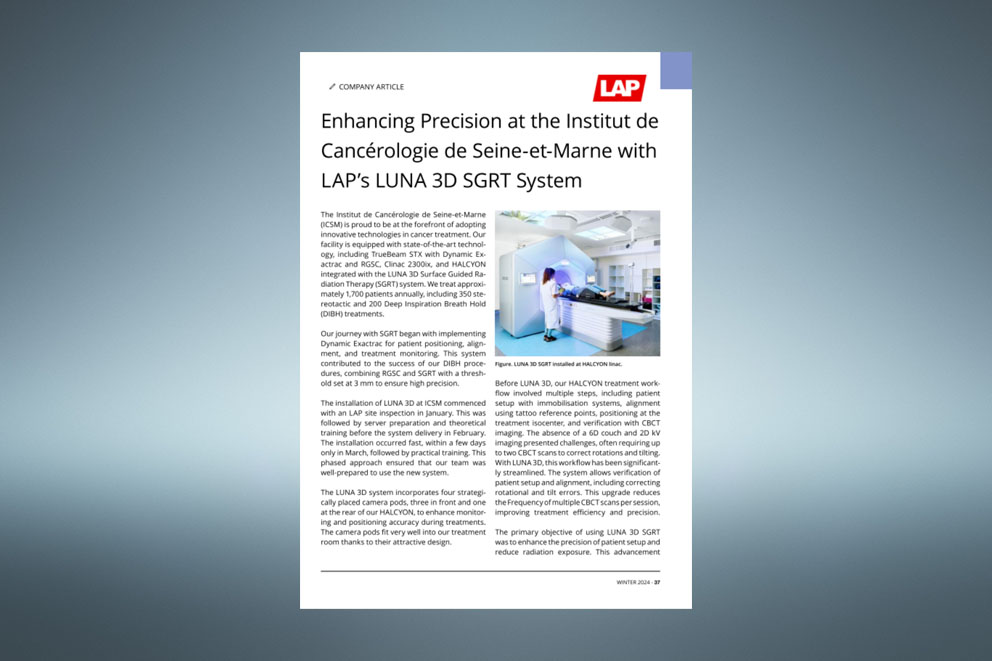Enhancing precision at the Institut de Cancérologie de Seine-et-Marne with LAP’s LUNA 3D SGRT system
By Charbel Kassis, Head of Medical Physics at the Institut de Cancérologie de Seine-et-Marne (ICSM)
The Institut de Cancérologie de Seine-et-Marne (ICSM) is proud to be at the forefront of adopting innovative technologies in cancer treatment. Our facility is equipped with state-of-the-art technology, including TrueBeam STX with Dynamic Exactrac and RGSC, Clinac 2300ix, and HALCYON integrated with the LUNA 3D Surface Guided Radiation Therapy (SGRT) system. We treat approximately 1,700 patients annually, including 350 stereotactic and 200 Deep Inspiration Breath Hold (DIBH) treatments.
Our journey with SGRT began with implementing Dynamic Exactrac for patient positioning, alignment, and treatment monitoring. This system contributed to the success of our DIBH procedures, combining RGSC and SGRT with a threshold set at 3 mm to ensure high precision.
The installation of LUNA 3D at ICSM commenced with an LAP site inspection in January. This was followed by server preparation and theoretical training before the system delivery in February. The installation occurred fast, within a few days only in March, followed by practical training. This phased approach ensured that our team was well-prepared to use the new system.
The LUNA 3D system incorporates four strategically placed camera pods, three in front and one at the rear of our HALCYON, to enhance monitoring and positioning accuracy during treatments. The camera pods fit very well into our treatment room thanks to their attractive design.
Before LUNA 3D, our HALCYON treatment workflow involved multiple steps, including patient setup with immobilisation systems, alignment using tattoo reference points, positioning at the treatment isocentre, and verification with CBCT imaging. The absence of a 6D couch and 2D kV imaging presented challenges, often requiring up to two CBCT scans to correct rotations and tilting. With LUNA 3D, this workflow has been significantly streamlined. The system allows verification of patient setup and alignment, including correcting rotational and tilt errors. This upgrade reduces the Frequency of multiple CBCT scans per session, improving treatment efficiency and precision.
The primary objective of using LUNA 3D SGRT was to enhance the precision of patient setup and reduce radiation exposure. This advancement saves time, decreases patient dose, and contributes to a more streamlined treatment process. Looking ahead, we aim to further optimise the use of LUNA 3D by moving towards eliminating tattoo reference points, thus enhancing the patient experience. Additionally, we are exploring the system's potential in continuous monitoring for improved safety and incorporating DIBH capabilities.
Implementing LUNA 3D at ICSM marks a significant step forward in our SGRT treatment capabilities. The LUNA 3D system ensures precise patient positioning and contributes to safer, more efficient treatments. We are excited about future advancements and sharing our experiences to support other medical physicists in embracing similar technologies. We received excellent support from the LAP branch in France throughout the project. We also had a team of experts from LAP Germany at our side. We are now looking forward to smooth, continuous clinical use for the benefit of our patients.
CV Mr. Kassis:
As Head of the Physics Unit at the Institut de Cancérologie de Seine et Marne (www.icsm77.com) for the past four years, Mr. Kassis brings 20 years of expertise across multiple radiotherapy centers. Throughout his career, he has played a key role in implementing advanced treatment techniques, from VMAT to cutting-edge stereotactic methods. He has led significant projects for expanding radiotherapy centers and installing state-of-the-art accelerators, including the TrueBeam STX and CyberKnife systems.

